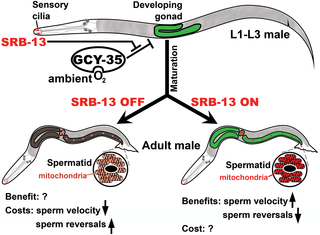PLOS Biology ( IF 9.8 ) Pub Date : 2017-06-29 , DOI: 10.1371/journal.pbio.2002047 Hieu D. Hoang , Michael A. Miller

|
The sperm’s crucial function is to locate and fuse with a mature oocyte. Under laboratory conditions, Caenorhabditis elegans sperm are very efficient at navigating the hermaphrodite reproductive tract and locating oocytes. Here, we identify chemosensory and oxygen-sensing circuits that affect the sperm’s navigational capacity. Multiple Serpentine Receptor B (SRB) chemosensory receptors regulate Gα pathways in gustatory sensory neurons that extend cilia through the male nose. SRB signaling is necessary and sufficient in these sensory neurons to influence sperm motility parameters. The neuropeptide Y pathway acts together with SRB-13 to antagonize negative effects of the GCY-35 hyperoxia sensor on spermatogenesis. SRB chemoreceptors are not essential for sperm navigation under low oxygen conditions that C. elegans prefers. In ambient oxygen environments, SRB-13 signaling impacts gene expression during spermatogenesis and the sperm’s mitochondria, thereby increasing migration velocity and inhibiting reversals within the hermaphrodite uterus. The SRB-13 transcriptome is highly enriched in genes implicated in pathogen defense, many of which are expressed in diverse tissues. We show that the critical time period for SRB-13 signaling is prior to spermatocyte differentiation. Our results support the model that young C. elegans males sense external environment and oxygen tension, triggering long-lasting downstream signaling events with effects on the sperm’s mitochondria and navigational capacity. Environmental exposures early in male life may alter sperm function and fertility.
中文翻译:

C中的化学感觉和高氧循环。线虫男性影响精子的导航能力
精子的关键功能是定位并融合成熟的卵母细胞。在实验室条件下,秀丽隐杆线虫精子在引导两性生殖生殖道和定位卵母细胞方面非常有效。在这里,我们确定了影响精子导航能力的化学感应和氧气感应电路。多种蛇形受体B(SRB)化学感觉受体调节味觉感觉神经元中的Gα通路,这些通路将纤毛延伸通过雄性鼻子。在这些感觉神经元中,SRB信号是必需的且足以影响精子运动参数。神经肽Y途径与SRB-13共同作用,拮抗GCY-35高氧传感器对精子发生的负面影响。在低氧条件下,SRB化学感受器对于精子导航不是必不可少的Ç。线虫更喜欢。在环境氧气环境中,SRB-13信号传导会影响精子发生和精子线粒体的基因表达,从而提高迁移速度并抑制雌雄同体子宫内的逆转。SRB-13转录组高度富集与病原体防御有关的基因,其中许多基因在不同的组织中表达。我们显示SRB-13信号的关键时间段是在精母细胞分化之前。我们的结果支持年轻C的模型。线虫雄性感觉到外部环境和氧气紧张,触发了持久的下游信号传导事件,对精子的线粒体和导航能力产生影响。男性早期生活在环境中可能会改变精子的功能和生育能力。



























 京公网安备 11010802027423号
京公网安备 11010802027423号